Trier
Trier | |
|---|---|
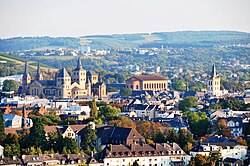 View over Trier | |
| Coordinates: 49°45′N 6°38′E / 49.750°N 6.633°E | |
| Country | Germany |
| State | Rhineland-Palatinate |
| District | Urban district |
| Government | |
| • Lord mayor | Wolfram Leibe (SPD) |
| Area | |
| • Total | 117.13 km2 (45.22 sq mi) |
| Elevation | 137 m (449 ft) |
| Population (2022-12-31)[1] | |
| • Total | 112,195 |
| • Density | 960/km2 (2,500/sq mi) |
| Demonym | Trevian |
| Time zone | UTC+01:00 (CET) |
| • Summer (DST) | UTC+02:00 (CEST) |
| Postal codes | 54290–54296 (except 54291) |
| Dialling codes | 0651 |
| Vehicle registration | TR |
| Website | www.trier.de |
Trier (/trɪər/ TREER,[2][3] German: [tʁiːɐ̯] ; Template:Lang-lb pronounced [ˈtʀəɪ̯ɐ] ), formerly known in English as Treves (/trɛv/ TREV;[4][5] French: Trèves [tʁɛv] Template:Lang-lat) and Triers (see also names in other languages), is a city on the banks of the Moselle in Germany. It lies in a valley between low vine-covered hills of red sandstone in the west of the state of Rhineland-Palatinate, near the border with Luxembourg and within the important Moselle wine region.
Founded by the Celts in the late 4th century BC as Treuorum and conquered 300 years later by the Romans, who renamed it Augusta Treverorum ("The City of Augustus among the Treveri"), Trier is considered Germany's oldest city.[6][7] It is also the oldest seat of a bishop north of the Alps. In the Middle Ages, the archbishop-elector of Trier was an important prince of the Church who controlled land from the French border to the Rhine. The archbishop-elector of Trier also had great significance as one of the seven electors of the Holy Roman Empire.
With an approximate population of 105,000, Trier is the fourth-largest city in its state, after Mainz, Ludwigshafen, and Koblenz.[8] The nearest major cities are Luxembourg (50 km or 31 mi to the southwest), Saarbrücken (80 kilometres or 50 miles southeast), and Koblenz (100 km or 62 mi northeast).
The University of Trier, the administration of the Trier-Saarburg district and the seat of the ADD (Aufsichts- und Dienstleistungsdirektion), which until 1999 was the borough authority of Trier, and the Academy of European Law (ERA) are all based in Trier. It is one of the five "central places" of the state of Rhineland-Palatinate. Along with Luxembourg, Metz and Saarbrücken, fellow constituent members of the QuattroPole union of cities, it is central to the greater region encompassing Saar-Lor-Lux (Saarland, Lorraine and Luxembourg), Rhineland-Palatinate, and Wallonia.
History
The first traces of human settlement in the area of the city show evidence of linear pottery settlements dating from the early Neolithic period. Since the last pre-Christian centuries, members of the Celtic tribe of the Treveri settled in the area of today's Trier.[9] The city of Trier derives its name from the later Latin locative in Trēverīs for earlier Augusta Treverorum.


The historical record describes the Roman Empire subduing the Treveri in the 1st century BC and establishing Augusta Treverorum about 16 BC.[10] The name distinguished it from the empire's many other cities honoring the first emperor Augustus. The city later became the capital of the province of Belgic Gaul; after the Diocletian Reforms, it became the capital of the prefecture of the Gauls, overseeing much of the Western Roman Empire. In the 4th century, Trier was one of the largest cities in the Roman Empire with a population around 75,000 and perhaps as much as 100,000.[11][12][13][14] The Porta Nigra ("Black Gate") dates from this era. A residence of the Western Roman Emperor, Roman Trier was the birthplace of Saint Ambrose. Sometime between 395 and 418, probably in 407 the Roman administration moved the staff of the Praetorian Prefecture from Trier to Arles. The city continued to be inhabited but was not as prosperous as before. However, it remained the seat of a governor and had state factories for the production of ballistae and armor and woolen uniforms for the troops, clothing for the civil service, and high-quality garments for the Court. Northern Gaul was held by the Romans along a line from north of Cologne to the coast at Boulogne through what is today southern Belgium until 460. South of this line, Roman control was firm, as evidenced by the continuing operation of the imperial arms factory at Amiens.

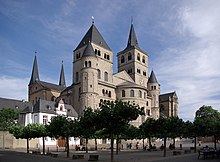

The Franks seized Trier from Roman administration in 459. In 870, it became part of Eastern Francia, which developed into the Holy Roman Empire. Relics of Saint Matthias brought to the city initiated widespread pilgrimages. The bishops of the city grew increasingly powerful and the Archbishopric of Trier was recognized as an electorate of the empire, one of the most powerful states of Germany. The University of Trier was founded in the city in 1473. In the 17th century, the Archbishops and Prince-Electors of Trier relocated their residences to Philippsburg Castle in Ehrenbreitstein, near Koblenz. A session of the Reichstag was held in Trier in 1512, during which the demarcation of the Imperial Circles was definitively established.
In the years from 1581 to 1593, the Trier witch trials were held, perhaps the largest witch trial in European history. It was certainly one of the four largest witch trials in Germany alongside the Fulda witch trials, the Würzburg witch trial, and the Bamberg witch trials. The persecutions started in the diocese of Trier in 1581 and reached the city itself in 1587, where it was to lead to the death of about 368 people, and was as such perhaps the biggest mass execution in Europe in peacetime. This counts only those executed within the city itself, and the real number of executions, counting also those executed in all the witch hunts within the diocese as a whole, was therefore even larger. The exact number of people executed has never been established; a total of 1,000 has been suggested but not confirmed.
In the 17th and 18th centuries, Trier was sought after by France, who invaded during the Thirty Years' War, the War of the Grand Alliance, the War of the Spanish Succession, and the War of the Polish Succession. France succeeded in finally claiming Trier in 1794 during the French Revolutionary Wars, and the electoral archbishopric was dissolved. After the Napoleonic Wars ended in 1815, Trier passed to the Kingdom of Prussia. The German philosopher and one of the founders of Marxism, Karl Marx was born in the city in 1818.
As part of the Prussian Rhineland, Trier developed economically during the 19th century. The city rose in revolt during the revolutions of 1848 in the German states, although the rebels were forced to concede. It became part of the German Empire in 1871.
In June 1940 over 60,000 British prisoners of war, captured at Dunkirk and Northern France, were marched to Trier, which became a staging post for British soldiers headed for German prisoner-of-war camps. Trier was heavily bombed and bombarded in 1944 during World War II. The city became part of the new state of Rhineland-Palatinate after the war. The university, dissolved in 1797, was restarted in the 1970s, while the Cathedral of Trier was reopened in 1974. Trier officially celebrated its 2,000th anniversary in 1984.
Geography
| Year | Pop. | ±% |
|---|---|---|
| 100 | 20,000 | — |
| 300 | 80,000 | +300.0% |
| 400 | 50,000 | −37.5% |
| 1250 | 12,000 | −76.0% |
| 1363 | 10,000 | −16.7% |
| 1542 | 8,500 | −15.0% |
| 1613 | 6,000 | −29.4% |
| 1702 | 4,300 | −28.3% |
| 1801 | 8,829 | +105.3% |
| 1871 | 21,442 | +142.9% |
| 1900 | 43,506 | +102.9% |
| 1910 | 49,112 | +12.9% |
| 1919 | 53,248 | +8.4% |
| 1919 | 57,341 | +7.7% |
| 1933 | 76,692 | +33.7% |
| 1939 | 88,150 | +14.9% |
| 1950 | 75,526 | −14.3% |
| 1961 | 87,141 | +15.4% |
| 1970 | 103,724 | +19.0% |
| 1987 | 94,118 | −9.3% |
| 2011 | 105,671 | +12.3% |
| 2018 | 110,636 | +4.7% |
| source:[15][circular reference] | ||
Trier sits in a hollow midway along the Moselle valley, with the most significant portion of the city on the east bank of the river. Wooded and vineyard-covered slopes stretch up to the Hunsrück plateau in the south and the Eifel in the north. The border with the Grand Duchy of Luxembourg is some 15 km (9 mi) away.
| Largest groups of foreign residents | |
| Country of birth | Population (2013) |
|---|---|
| 688 | |
| 675 | |
| 573 | |
| 476 | |
| 444 | |
Neighbouring municipalities
Listed in clockwise order, beginning with the northernmost; all municipalities belong to the Trier-Saarburg district
Schweich, Kenn and Longuich (all part of the Verbandsgemeinde Schweich an der Römischen Weinstraße), Mertesdorf, Kasel, Waldrach, Morscheid, Korlingen, Gutweiler, Sommerau and Gusterath (all in the Verbandsgemeinde Ruwer), Hockweiler, Franzenheim (both part of the Verbandsgemeinde Trier-Land), Konz (Verbandsgemeinde Konz), Igel, Trierweiler, Aach, Newel, Kordel, Zemmer (all in the Verbandsgemeinde Trier-Land)
Organization of city districts

The Trier urban area is divided into 19 city districts. For each district there is an Ortsbeirat (local council) of between 9 and 15 members, as well as an Ortsvorsteher (local representative). The local councils are charged with hearing the important issues that affect the district, although the final decision on any issue rests with the city council. The local councils nevertheless have the freedom to undertake limited measures within the bounds of their districts and their budgets.
The districts of Trier with area and inhabitants (December 31, 2009):
| Official district number | District with associated sub-districts | Area in km2 |
Inhabitants |
|---|---|---|---|
| 11 | Mitte/Gartenfeld | 2.978 | 11,954 |
| 12 | Nord (Nells Ländchen, Maximin) | 3.769 | 13,405 |
| 13 | Süd (St. Barbara, St. Matthias or St. Mattheis) | 1.722 | 9,123 |
| 21 | Ehrang/Quint | 26.134 | 9,195 |
| 22 | Pfalzel | 2.350 | 3,514 |
| 23 | Biewer | 5.186 | 1,949 |
| 24 | Ruwer/Eitelsbach | 9.167 | 3,091 |
| 31 | West/Pallien | 8.488 | 7,005 |
| 32 | Euren (Herresthal) | 13.189 | 4,207 |
| 33 | Zewen (Oberkirch) | 7.496 | 3,634 |
| 41 | Olewig | 3.100 | 3,135 |
| 42 | Kürenz (Alt-Kürenz, Neu-Kürenz) | 5.825 | 8,708 |
| 43 | Tarforst | 4.184 | 6,605 |
| 44 | Filsch | 1.601 | 761 |
| 45 | Irsch | 4.082 | 2,351 |
| 46 | Kernscheid | 3.768 | 958 |
| 51 | Feyen/Weismark | 5.095 | 5,689 |
| 52 | Heiligkreuz (Alt-Heiligkreuz, Neu-Heiligkreuz, St. Maternus) | 2.036 | 6,672 |
| 53 | Mariahof (St. Michael) | 7.040 | 3,120 |
| Totals | 117.210 | 105,076 |
Climate
Trier has an oceanic climate (Köppen: Cfb), but with greater extremes than the marine versions of northern Germany. Summers are warm except in unusual heat waves and winters are recurrently cold, but not harsh. Precipitation is high despite not being on the coast.[16] As a result of the European heat wave in 2003, the highest temperature recorded was 39 °C on 8 August of that year. The lowest recorded temperature was −19.3 °C on February 2, 1956.[17]
| Climate data for Trier (Petrisberg), elevation: 265 m, 1971–2000 normals | |||||||||||||
|---|---|---|---|---|---|---|---|---|---|---|---|---|---|
| Month | Jan | Feb | Mar | Apr | May | Jun | Jul | Aug | Sep | Oct | Nov | Dec | Year |
| Mean daily maximum °C (°F) | 3.7 (38.7) |
5.3 (41.5) |
9.8 (49.6) |
13.7 (56.7) |
18.6 (65.5) |
21.3 (70.3) |
23.8 (74.8) |
23.9 (75.0) |
19.5 (67.1) |
13.7 (56.7) |
7.4 (45.3) |
4.7 (40.5) |
13.8 (56.8) |
| Daily mean °C (°F) | 1.4 (34.5) |
2.1 (35.8) |
5.6 (42.1) |
8.5 (47.3) |
13.1 (55.6) |
15.9 (60.6) |
18.1 (64.6) |
17.8 (64.0) |
14.0 (57.2) |
9.6 (49.3) |
4.7 (40.5) |
2.5 (36.5) |
9.4 (49.0) |
| Mean daily minimum °C (°F) | −0.9 (30.4) |
−0.8 (30.6) |
2.0 (35.6) |
4.0 (39.2) |
8.2 (46.8) |
11.1 (52.0) |
13.0 (55.4) |
12.8 (55.0) |
9.8 (49.6) |
6.3 (43.3) |
2.3 (36.1) |
0.4 (32.7) |
5.7 (42.2) |
| Average precipitation mm (inches) | 62.3 (2.45) |
52.0 (2.05) |
60.8 (2.39) |
52.0 (2.05) |
67.0 (2.64) |
68.0 (2.68) |
72.3 (2.85) |
59.6 (2.35) |
62.2 (2.45) |
70.5 (2.78) |
70.7 (2.78) |
76.8 (3.02) |
774.2 (30.49) |
| Average precipitation days (≥ 1.0 mm) | 12.2 | 9.7 | 11.6 | 9.4 | 11.3 | 11.2 | 10.2 | 8.4 | 9.1 | 10.5 | 11.6 | 12.3 | 127.5 |
| Source: DWD | |||||||||||||
| Climate data for Trier (Petrisberg), elevation: 273 m, 1961–1990 normals and extremes | |||||||||||||
|---|---|---|---|---|---|---|---|---|---|---|---|---|---|
| Month | Jan | Feb | Mar | Apr | May | Jun | Jul | Aug | Sep | Oct | Nov | Dec | Year |
| Record high °C (°F) | 14.3 (57.7) |
18.1 (64.6) |
23.7 (74.7) |
28.5 (83.3) |
30.7 (87.3) |
34.6 (94.3) |
37.1 (98.8) |
35.8 (96.4) |
33.1 (91.6) |
26.3 (79.3) |
19.4 (66.9) |
17.0 (62.6) |
37.1 (98.8) |
| Mean daily maximum °C (°F) | 3.1 (37.6) |
5.1 (41.2) |
9.1 (48.4) |
13.4 (56.1) |
18.1 (64.6) |
21.2 (70.2) |
23.3 (73.9) |
22.9 (73.2) |
19.5 (67.1) |
14.1 (57.4) |
7.4 (45.3) |
4.0 (39.2) |
13.4 (56.2) |
| Daily mean °C (°F) | 0.9 (33.6) |
1.9 (35.4) |
4.9 (40.8) |
8.4 (47.1) |
12.6 (54.7) |
15.7 (60.3) |
17.6 (63.7) |
17.1 (62.8) |
14.0 (57.2) |
9.8 (49.6) |
4.6 (40.3) |
1.8 (35.2) |
9.1 (48.4) |
| Mean daily minimum °C (°F) | −1.4 (29.5) |
−0.9 (30.4) |
1.4 (34.5) |
4.0 (39.2) |
7.8 (46.0) |
10.9 (51.6) |
12.5 (54.5) |
12.3 (54.1) |
9.7 (49.5) |
6.4 (43.5) |
2.2 (36.0) |
−0.4 (31.3) |
5.4 (41.7) |
| Record low °C (°F) | −18.3 (−0.9) |
−14.6 (5.7) |
−12.9 (8.8) |
−6.2 (20.8) |
−1.6 (29.1) |
1.7 (35.1) |
4.4 (39.9) |
4.2 (39.6) |
1.2 (34.2) |
−3.4 (25.9) |
−10.2 (13.6) |
−14.4 (6.1) |
−18.3 (−0.9) |
| Average precipitation mm (inches) | 60.0 (2.36) |
55.0 (2.17) |
64.0 (2.52) |
53.0 (2.09) |
68.0 (2.68) |
73.0 (2.87) |
70.0 (2.76) |
71.0 (2.80) |
59.0 (2.32) |
65.0 (2.56) |
74.0 (2.91) |
72.0 (2.83) |
784 (30.87) |
| Average precipitation days (≥ 1.0 mm) | 12.0 | 10.0 | 12.0 | 10.0 | 12.0 | 11.0 | 10.0 | 10.0 | 9.0 | 9.0 | 12.0 | 12.0 | 129 |
| Mean monthly sunshine hours | 43.6 | 76.9 | 114.3 | 156.9 | 203.4 | 206.3 | 225.5 | 200.5 | 152.4 | 103.3 | 49.4 | 40.1 | 1,572.6 |
| Source: NOAA[18] | |||||||||||||
Main sights
| UNESCO World Heritage Site | |
|---|---|
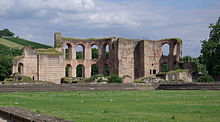 Ruins of the Imperial Baths | |
| Includes | Amphitheater, Roman bridge, Barbara Baths, Igel Column, Porta Nigra, Imperial Baths, Aula Palatina, Cathedral and Liebfrauenkirche |
| Criteria | Cultural: i, iii, iv, vi |
| Reference | 367 |
| Inscription | 1986 (10th Session) |
Trier is known for its well-preserved Roman and medieval buildings, which include:
- the Porta Nigra, the best-preserved Roman city gate north of the Alps;
- the huge Constantine Basilica, a basilica in the original Roman sense, was the 67 m (219.82 ft) long throne hall of Roman Emperor Constantine; it is today used as a Protestant church; adjacent is the Electoral Palace, Trier;
- the Roman Trier Amphitheater;
- the 2nd century AD Roman bridge (Römerbrücke) across the Moselle, the oldest bridge north of the Alps still crossed by traffic;
- ruins of three Roman baths, among them the largest Roman baths north of the Alps; including the Barbara Baths and the Trier Imperial Baths;
- Trier Cathedral (German: Trierer Dom or Dom St. Peter), a Catholic church that dates back to Roman times; its Romanesque west façade with an extra apse and four towers is imposing and has been copied repeatedly; the Cathedral is home to the Holy Tunic, a garment said to be the robe Jesus was wearing when he died, as well as many other relics and reliquaries in the Cathedral Treasury;
- the Liebfrauenkirche (German for Church of Our Lady), which is one of the most important early Gothic churches in Germany, in some ways comparable to the architectural tradition of the French Gothic cathedrals;
- St. Matthias' Abbey (Abtei St. Matthias), a still-in-use monastery in whose medieval church the only apostle north of the Alps is held to be buried;
- St. Gangolf's church is the city's 'own' church near the main market square (as opposed to the Cathedral, the bishop's church); largely Gothic;
- Saint Paulinus' Church, one of the most important Baroque churches in Rhineland-Palatinate and designed in part by the architect Balthasar Neumann;
- two old treadwheel cranes, one being the Gothic "Old Crane" (Alte Krahnen) or "Trier Moselle Crane" (Trierer Moselkrahn) from 1413, and the other the 1774 Baroque crane called the "(Old) Customs Crane" ((Alter) Zollkran) or "Younger Moselle Crane" (Jüngerer Moselkran) (see List of historical harbour cranes).
Museums

- Rheinisches Landesmuseum (an important archaeological museum for the Roman period; also some early Christian and Romanesque sculpture);
- Domschatzkammer (Treasury of Trier Cathedral; with the Egbert Shrine, the reliquary of the Holy Nail, the cup of Saint Helena and other reliquaries, liturgical objects, ivories, manuscripts, etc., many from the Middle Ages);
- Museum am Dom, formerly Bischöfliches Dom- und Diözesanmuseum (Museum of the Diocese of Trier; religious art, also some Roman artefacts);
- Stadtmuseum Simeonstift (history of Trier, displaying among other exhibits a scale model of the medieval city);
- Karl Marx House; a museum exhibiting Marx's personal history, volumes of poetry, original letters, and photographs with personal dedications. There is also a collection of rare first editions and international editions of his works, as well as exhibits on the development of socialism in the 19th century;
- Toy Museum of Trier;
- Ethnological and open-air museum Roscheider Hof, a museum in the neighbouring town of Konz, right at the city limits of Trier, which shows the history of rural culture in the northwest Rhineland Palatinate and in the area where Germany, Luxembourg and Lorraine meet;
- Fell Exhibition Slate Mine; site in the municipality of Fell, 20 km (12 mi) from Trier, containing an underground mine, a mine museum, and a slate mining trail.
Education


Trier is home to the University of Trier, founded in 1473, closed in 1796 and restarted in 1970. The city also has the Trier University of Applied Sciences. The Academy of European Law (ERA) was established in 1992 and provides training in European law to legal practitioners. In 2010 there were about 40 Kindergärten,[19] 25 primary schools and 23 secondary schools in Trier, such as the Humboldt Gymnasium Trier, Max Planck Gymnasium, Auguste Viktoria Gymnasium and the Nelson-Mandela Realschule Plus, Kurfürst-Balduin Realschule Plus, Realschule Plus Ehrang.[20]
Annual events


- Until 2014, Trier was home to Germany's largest Roman festival, Brot und Spiele (German for Bread and Games – a translation of the famous Latin phrase panem et circenses from the satires of Juvenal)
- Trier has been the base for the German round of the World Rally Championship since 2002, with the rally's presentation held next to the Porta Nigra.
- Trier holds a Christmas street festival every year called the Trier Christmas Market on the Hauptmarkt (Main Market Square) and the Domfreihof in front of the Cathedral of Trier.
Transportation
Trier station has direct railway connections to many cities in the region. The nearest cities by train are Cologne, Saarbrücken and Luxembourg. Via the motorways A 1, A 48 and A 64 Trier is linked with Koblenz, Saarbrücken and Luxembourg. The nearest commercial (international) airports are in Luxembourg (0:40 h by car), Frankfurt-Hahn (1:00 h), Saarbrücken (1:00 h), Frankfurt (2:00 h) and Cologne/Bonn (2:00 h). The Moselle is an important waterway and is also used for river cruises. A new passenger railway service on the western side of the Mosel is scheduled to open in December 2018.[21]
Sports
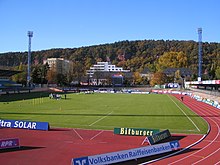
Major sports clubs in Trier include:
- SV Eintracht Trier 05, association football
- Gladiators Trier, basketball (former TBB Trier)
- DJK/MJC Trier, women's team handball
- Trier Cardinals, baseball
- PST Trier Stampers, American Football
- FSV Trier-Tarforst, intera alia football and rugby
Notable residents
See Heinz Monz: Trierer Biographisches Lexikon. Landesarchivverwaltung Rheinland-Pfalz, Koblenz 2000. 539 p. ISBN 3-931014-49-5.


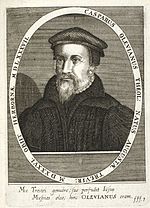
- Eucharius (died ~250), first bishop of Trier
- Constantius I. Chlorus (ca. 250-306), Roman emperor
- Maximian (ca. 250–310), Roman emperor
- Valerius (died 320), second bishop of Trier
- St Athanasius (In exile ca. 335)
- Helena (ca. 250–330), saint, mother of Constantine the Great (residence in Trier by tradition)[22][23]
- Constantine the Great (ca. 272-337), Roman emperor
- Paulinus (died 358), bishop of Trier
- Valentinian I (321–375), Roman emperor
- Ausonius (ca. 310–395), Roman consul and poet
- Ambrose (ca. 340–397), saint
- Apronia of Toul, (6th century), nun and saint
- Kaspar Olevianus (1536–1587), theologian
- Heinrich (1777–1838) and Henriette Marx (1788–1863), parents of Karl Marx
- Johann Anton Ramboux (1790–1866), painter
- Jenny Marx née von Westphalen (1814–1881), revolutionary, drama critic, wife of Karl Marx, mother of Jenny Longuet, Laura Marx and Eleanor Marx
- Karl Marx (1818–1883), German social philosopher and revolutionary
- August Beer (1825–1863), scientist
- Frederick A. Schroeder (1833–1899), American politician, mayor of Brooklyn
- Hans am Ende (1864–1918), German painter
- Ludwig Kaas (1881–1952), Catholic priest and politician of the Zentrum
- Oswald von Nell-Breuning (1890–1991), German theologian
- Charles de Gaulle (1890–1970), General and French statesman, as commander of a battalion of Chasseurs during the French occupation of Rhineland
- Reinhard Heß (1904–1998), painter and glass painter
- Wolf Graf von Baudissin (1907–1993), German general, military planner and peace researcher
- Peter Thullen (1907–1996), German-Ecuadorian mathematician
- Klaus Barbie (1913–1991), SS and Gestapo functionary during the Nazi era.
- Gitta Lind (1925–1974), singer (e.g. "White Elder")
- Reinhold Bartel (1926–1996), operatic tenor
- Ernst Huberty (born 1927), sports reporter ("Mister Sportschau")
- Günther Steines (1928–1982), athlete
- Franz Grundheber (born 1937), baritone
- Otmar Seul (born 1943), lawyer, professor
- Helga Zepp-LaRouche (born 1948), journalist and politician
- Xavier Bout de Marnhac (born 1951), French general, former commander of KFOR
- Robert Zimmer (born 1953), German philosopher and essayist
- Ernst Ulrich Deuker (born 1954), musician of Ideal
- François Weigel (born 1964), French pianist, composer and conductor
- Eric Jelen (born 1965), tennis player
- Martin Bambauer (born 1970), church musician
- Frank Findeiß (born 1971), poet
- The Shanes (German polka band)
International relations
Trier is a fellow member of the QuattroPole union of cities, along with Luxembourg, Saarbrücken, and Metz (neighbouring countries: Luxembourg and France).
Twinning
Trier is twinned with:
|
|
Namesakes
 New Trier Township, Illinois, USA, originally settled by people from Trier.
New Trier Township, Illinois, USA, originally settled by people from Trier. New Trier, Minnesota, USA, settled by people from Trier about 1856.
New Trier, Minnesota, USA, settled by people from Trier about 1856. New Trier High School, an Illinois school named after Trier.
New Trier High School, an Illinois school named after Trier.
References
- ^ "Bevölkerungsstand 2022, Kreise, Gemeinden, Verbandsgemeinden" (PDF) (in German). Statistisches Landesamt Rheinland-Pfalz. 2023.
- ^ "Trier" (US) and "Trier". Oxford Dictionaries UK English Dictionary. Oxford University Press. n.d. Retrieved April 2, 2019.
- ^ "Trier". Merriam-Webster.com Dictionary. Merriam-Webster.
- ^ "Trèves" (US) and "Trèves". Oxford Dictionaries UK English Dictionary. Oxford University Press. n.d. Retrieved April 2, 2019.
- ^ "Trèves". The American Heritage Dictionary of the English Language (5th ed.). HarperCollins. Retrieved April 2, 2019.
- ^ Rathaus der Stadt Trier. "Stadt Trier – City of Trier – La Ville de Trèves | Website of the Municipality of Trier". web.archive.org. Archived from the original on 2002-08-08. Retrieved 2015-08-26.
- ^ An honor that is contested by Cologne, Kempten, and Worms.
- ^ "Bevölkerung der Gemeinden am 31.12.2010" (PDF). Statistisches Landesamt Rheinland-Pfalz (in German). 2011. Archived from the original (PDF) on 2012-01-31.
- ^ See: Heinen, pp. 1–12.
- ^ The City of Trier, Uni Trier, retrieved 11 May 2019
- ^ "TRIER THE CENTER OF ANTIQUITY IN GERMANY" (PDF). 8 March 2012. Retrieved 2015-08-26.
- ^ LaVerne, F.K. (1991). Europe by Eurail 2010: Touring Europe by Train. Globe Pequot Press. p. 337. ISBN 9780762761630. Retrieved 2015-08-26.
- ^ 2.
- ^ "The Fall and Decline of the Roman Urban Mind | Svante Fischer and Helena Victor - Academia.edu". academia.edu. Retrieved 2015-08-26.
- ^ Link
- ^ "Trier, Germany Köppen Climate Classification (Weatherbase)". Weatherbase. Retrieved 2019-02-02.
- ^ "Wetterrekorde Deutschland". Wetterdienst.de (in German). Retrieved 2019-02-02.
- ^ "Trier (10609) – WMO Weather Station". NOAA. Retrieved February 2, 2019.
- ^ "Stadt Trier – Startseite | Kindergärten in Trier". cms.trier.de. Retrieved 2015-08-26.
- ^ "Stadt Trier – Startseite – Schulen in Trier". cms.trier.de. Retrieved 2015-08-26.
- ^ Fender, Keith (12 February 2014). "Plans approved for Trier suburban line Written by". International Railway Journal. Retrieved 2014-02-25.
- ^ "Catholic Encyclopedia – St. Helena – Ökumenisches Heiligenlexikon". heiligenlexikon.de. Retrieved 2015-08-26.
- ^ "Trierer Persönlichkeiten aus über 2000 Jahren: Kaiserin Helena" [Trier personalities from over 2000 years: Empress Helena]. Trier.de (in German). City of Trier. Retrieved February 23, 2020.
- ^ "Međunarodna suradnja Grada Pule". Grad Pula (in Croatian and Italian). Archived from the original on 2012-05-05. Retrieved 2013-07-28.
- ^ "Fort Worth". Sister Cities International. Archived from the original on 2014-04-13. Retrieved 2014-04-11.
External links
- Official website
 (in German)
(in German) - . New International Encyclopedia. 1905.
- Gough, Alfred Bradley (1911). . Encyclopædia Britannica. Vol. 27 (11th ed.). pp. 268–269.






